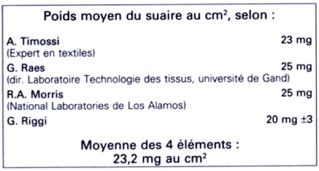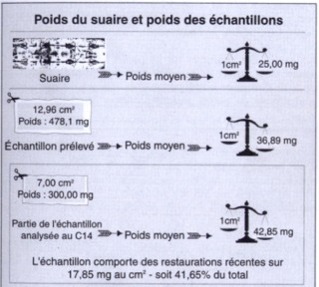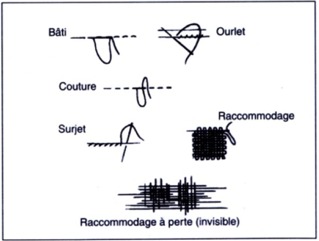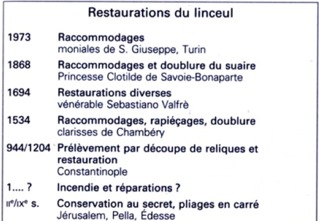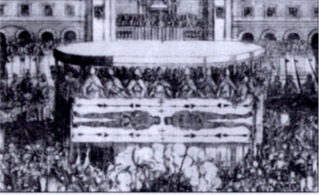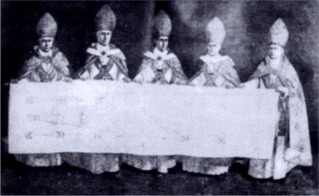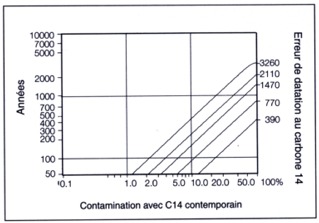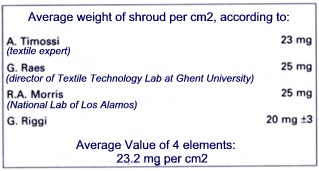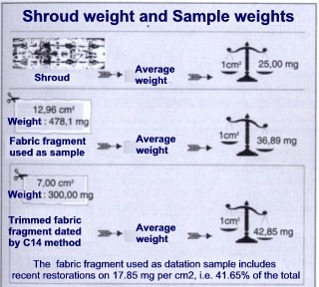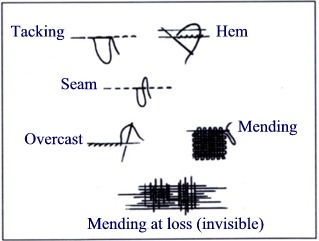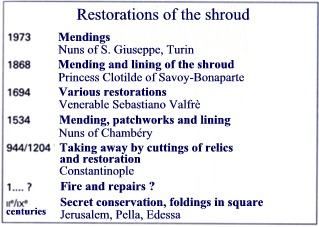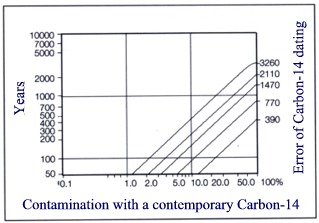Une autre explication pour l'erreur de datation a été proposée par l'archéologue italienne Maria-Grazia Siliato : la région choisie pour les prélèvements, souvent manipulée, a pu être endommagée puis restaurée avec un tel soin que ce point aurait échappé aux experts.
Le poids moyen du suaire
Le poids moyen du suaire se situe entre 20 et 23 milligrammes au centimètre carré. Le poids des fragments du suaire utilisés pour la datation au carbone 14 est en revanche de plus de 42 milligrammes au centimètre carré. Mais la radiodatation ne tint pas compte de cette différence flagrante.
Depuis longtemps, le poids moyen du suaire au centimètre carré avait été évalué sur la base des titres de la chaîne et de la trame - c'est-à-dire selon le système de mesures en vigueur dans le commerce -, par le professeur Timossi, expert en matières textiles et par le professeur Gilbert Raes, directeur du laboratoire de technologie des tissus à l'université de Gand. Il avait été calculé « radiographiquement » en 1978 par R.A. Morris, du STURP. Les données se révélèrent concordantes.
Mais si l'on considère que le suaire est un tissu d'origine antique, artisanal et donc présentant de légères irrégularités, il est prudent d'ajouter à la moyenne de ces mesures une tolérance en plus, de 10 pour cent, et donc d'attribuer au poids moyen du tissu la valeur de 25 milligrammes par centimètre carré.
Le prélèvement du fragment de tissu sur lequel devait être effectuée la radiodatation a été intégralement enregistré sur bande vidéo. Cette opération, en présence de nombreuses personnalités intéressées à divers titres, consista à découper un fragment dans le coin supérieur gauche, déjà mutilé par une entaille précédente.
Ce fragment, qui allait devenir célèbre, était un rectangle grossier qui mesurait 8,1 cm x 1,6 cm - et dont la superficie était donc de 12,96 cm2.
La balance de haute précision attribua au fragment un poids de 478,1 mg. Si l'on divise son poids par sa surface (478,1 : 12,96), on obtient un poids de 36,89 mg au cm2, soit 11,89 mg au cm2 de plus que le poids moyen du tissu du suaire.
Mais la personne qui réalisa le prélèvement estima nécessaire « d'ébarber » le fragment, en supprimant quelques irrégularités et fils libres. Il le réduisit donc aux dimensions de 7 x 1 cm, soit une superficie de 7 cm2.
Le poids de la partie du fragment « ébarbé » s'avéra être de 300 mg. Si on divise ce poids par la surface (300 : 7), on découvre que le poids au centimètre carré s'est encore accru : 42,85 mg au centimètre carré, soit 5,96 mg de plus.
Le fragment sur lequel s'opéra la datation au carbone 14 concluant à une origine médiévale pesait donc 17,85 mg au cm2 de plus que le poids moyen de la totalité du suaire qui était de 25 mg au cm2.
Cela signifie que ce fragment était chargé d'une forte quantité de matériau textile étranger au tissu d'origine. A quoi était due cette augmentation considérable de poids ?
De minutieuses et anciennes réparations, et leur poids
Le suaire a subi au fil des siècles de lourdes restaurations. On peut y discerner un véritable catalogue des points de raccommodage : bâti, ourlet, faufilage, surjet, raccommodage proprement dit et point de chaînette.
On voit des ajouts de toile de renfort aux angles, des rapiéçages sur les parties brûlées, on sait que la totalité de la surface du tissu fut doublée avec une toile de Hollande de dimension identique, que l'on fixa grâce à une quantité innombrable de points passant à travers les deux tissus pris ensemble, points qui « se confondent parfaitement avec les fils du suaire », déclarèrent les observateurs.
Outre les réparations, de larges zones furent renforcées ou même reconstruites à l'aide d'une technique exigeant de la patience et une grande délicatesse, celle du " raccommodage à perte, invisible ", qui consiste en des fils que l'on insère entre ceux de la trame et de la chaîne, coupés à chaque extrémité, sans nœuds, et qui se " perdent " dans le tissu existant.
Le lin méditerranéen du linceul, en raison de sa très ancienne structure artisanale et donc irrégulière, de son calibre assez fort et de son tissage serré en chevrons, intègre particulièrement bien tous les types d'interventions.
Au cours des siècles, la relique fut exposée aux foules pratiquement toujours de la même façon. La forme de la double empreinte obligeait à la présenter horizontalement, entièrement dépliée. La partie où était reproduit le visage était conventionnellement placée à gauche du spectateur pour faciliter la lecture naturelle - de gauche à droite - du long rectangle.
Une gravure reproduisant une ostension du Saint Suaire au XVIIe siècle montre nettement le tissu tenu en main par la bordure supérieure : c'est sur cette bordure que fut prélevé le fragment destiné à la datation au carbone 14. En effet, l'empreinte antérieure du corps est présentée à gauche du spectateur.
Une autre illustration de 1898 montre le Saint Suaire présenté à la foule de la même manière, les mains le tiennent, sans protection, toujours par le même bord qui fut donc souvent maltraité au cours des siècles, mais garantissent au public la vision la plus logique, parfaite, de l'empreinte du corps vue de face à gauche du spectateur.
En octobre 1976, Riccardo Gervasio avait publié une étude minutieuse sur les restaurations et les réparations subies par le suaire. Il avait lui aussi retrouvé dans les coins supérieurs droit et gauche du suaire des incrustations de tissu avec des surpiqûres et des coutures renforcées en surjet, d'époque médiévale, pour soutenir et partiellement rapiécer l'original qui s'était littéralement effiloché au cours des siècles comme la bordure d'un tapis usé.
En 1978, R.W. Mottern, R.J. London et R.A. Morris avaient effectué des examens radiographiques de cette partie : ils avaient vu que l'homogénéité du tissu présentait des disparités considérables, des parties de « faible densité » c'est-à-dire effilochées et détériorées, voisinant avec d'autres, d'une « densité » très élevée c'est-à-dire lourdement restaurées : la découverte fut publiée dans les revues scientifiques.
Malheureusement, on renonça à effectuer un prélèvement de fragments de fils provenant de diverses parties du tissu, ce qui aurait évité des mutilations et offert à la radiodatation un « échantillon » véritablement représentatif.
Selon le rapport de l'opérateur du prélèvement, le fragment renforcé « fut ensuite divisé en plusieurs parties, dont trois identiques, d'un poids à peine supérieur à 50 mg, qui furent placées dans trois récipients... ». Cela signifie que sur les 478,1 mg du prélèvement initial seuls 150 mg parvinrent aux trois laboratoires. Ces échantillons étaient pris dans la partie du suaire qui présentait le poids moyen au centimètre carré le plus élevé.
Dans quelle mesure une contamination récente peut-elle perturber les données d'une radiodatation techniquement très soignée ? Les démonstrations effectuées en laboratoire l'expliquent.
Le souvenir visible de nombreuses réparations, les très évidentes discordances de poids, laissent penser à bon droit que les fragments utilisés pour les datations au carbone 14 du suaire par les trois laboratoires sont tous chargés, dans des proportions très variables, de matériaux textiles étrangers et indéterminés.
Les laboratoires d'analyses procèdent habituellement à un nettoyage rigoureux des échantillons destinés à la radiodatation, ils éliminent les impuretés et les corps étrangers, mais les fils de lin de raccommodage, unis à l'original en une structure homogène, ne pouvaient pas être éliminés.
L'entremêlement de matériaux plus jeunes du point de vue de l'analyse par radiodatation - de combien ? douze, quinze, seize siècles ? - a augmenté dans des proportions considérables et imprécises la quantité de carbone 14 résiduel sur les fragments à dater.
Étant donné les résultats de l'opération Fire Simulating Model, et les graves discordances de poids entre les parties d'origine et celles qui avaient subi des réparations, une seule chose est sûre aujourd'hui : personne ne sait véritablement sur quoi la datation au carbone 14 a été effectuée.
Another explanation for the error of dating was proposed by the Italian archaeologist Maria-Grazia Siliato: the area chosen for the samples, often handled, could be damaged then restored with such a care that this point would be unnoticed by the experts.
The average weight of the shroud
The average weight of the shroud ranges between 20 and 23 milligrams per square centimeter. On the other hand the weight of the shroud fragments used for the Carbon-14 dating is more than 42 milligrams per square centimeter. But the radiodatation did not hold account of this obvious difference.
For a long time, the average weight of the shroud per square centimeter had been evaluated on the basis of the weaving standards of the weft yarns and the warp yarns - i.e. according to the system of measurement in force in the trade -, by professor Timossi, expert in textile materials and by professor Gilbert Raes, director of the textile technology laboratory at the university of Ghent. It had been calculated « radiographically » in 1978 by R.A. Morris, of the STURP. The data appeared concordant.
But if one takes into account that the shroud is an ancient fabric, handicraft-made and thus presenting light irregularities, it is careful to add to the average of these measurements a tolerance of 10 percent, and consequently to allocate to the average fabric weight a value of 25 milligrams per square centimeter.
The taking away of the fabric fragment, on which the radiodatation was to be performed, was completely recorded on a videotape. This operation, in the presence of many personalities interested for various reasons, consisted in cutting out a fragment in the left higher corner, already mutilated by a former notch.
This fragment, which was going to become famous, was a crude rectangle which measured 8.1 cm X 1.6 cm - and whose surface was thus 12.96 cm2.
The high precision balance allocated to the fragment a weight of 478.1 mg. If one divides its weight by its surface (478.1 : 12.96), one obtains a weight of 36.89 mg per cm2, or 11.89 mg per cm2 more than the average weight of shroud fabric.
But the person who performed the taking away considered it was necessary « to trim » the fragment, by removing some irregularities and free wires. He thus reduced it to dimensions of 7 X 1 cm, that is to say a surface of 7 cm2.
The weight of the « trimmed » fragment turned out to be of 300 mg. If one divides this weight by the surface (300: 7), one discovers that the weight per square centimeter still increased: 42.85 mg per square centimeter, or 5.96 mg more.
The fragment, on which the carbon-14 dating performed and concluded to the medieval origin, weighed thus 17.85 mg per cm2 more than the average weight of the whole shroud which was 25 mg per cm2.
That means this fragment was loaded with a strong quantity of textile material not to belonged to the original fabric. How to explain this considerable increase in weight?
Meticulous and old repairs, and their weight.
The shroud has been subjected to heavy restorations with the passing centuries. One can distinguish there a true catalog of the mending points: tacking stitch, hem, basting, overcast stitch, mending itself and chain stitch.
One sees additions of strengthening fabric to the angles, patchworks on the burned parts, one knows that the whole surface of fabric was doubled with a Holland fabric of identical dimension, that one fixed thanks to an innumerable quantity of points passing through the two fabrics taken together, points which « merge perfectly with the wires of the shroud », declared the observers.
In addition to repairs, broad zones were reinforced or even rebuilt using a technique requiring patience and a great delicacy, that of « mending at loss, invisible », which consists of wires inserted between those of the weft yarns and the warp yarns, cut at each end, without knots, and which « are lost » in existing fabric.
The Mediterranean linen cloth of the shroud, because of its very old handicraft and thus irregular structure, of its rather strong gauge and its tightened weaving in rafters, integrates particularly well all the types of interventions.
During centuries, the relic was exhibited to crowd practically always in the same way. The shape of the double imprint obliged to present it horizontally, entirely unfolded. The part where the face was reproduced was conventionally placed on the left of the spectator to facilitate the natural viewing - from left to right - of the long rectangle.
An engraving reproducing an exhibition of Holy Shroud in the XVII century clearly shows the fabric held in hand by the higher edge: it is on this edge that the fragment used for the carbon-14 dating was taken. Indeed, the former imprint of the body is presented on the left of the spectator.
Another illustration of 1898 shows the Holy Shroud presented to the crowd in the same way, the hands hold it, without protection, always by the same edge which was thus often maltreated during centuries, but it was for the public the most logical, perfect vision of the body imprint, front view on the left of the spectator.
In October 1976, Riccardo Gervasio had published a meticulous study on the restorations and the repairs undergone by the shroud. He had also found in the higher right and left corners of the shroud some fabric incrustations with topstitches and seams reinforced in overcast, of medieval time, to support and partially patch up the original which had literally frayed during centuries as the edge of a worn carpet.
In 1978, R.W. Mottern, R.J. London and R.A. Morris had performed radiographic examinations of this part: they had seen that the homogeneity of fabric had considerable disparities, parts of « low density » that is to say frayed and deteriorated, being placed side by side with others of very high « density » that is to say heavily restored: the discovery was published in the scientific magazines.
Unfortunately, one abandoned to perform a taking away of wire fragments coming from various parts of fabric, which would have avoided mutilations and offered to the radiodatation a truly representative « sample ».
According to the report of the operator in charge of the taking away, the reinforced fragment « was then divided into several parts, including three identical, of a weight hardly higher than 50 mg, which was placed in three containers... ». That means that on the 478.1 mg of the initial taking away only 150 mg arrived at the three laboratories. These samples were taken in the part of the shroud which presented the highest average weight per square centimeter.
Is it possible that a recent contamination can disturb the data of a radiodatation technically very meticulously prepared ? The demonstrations performed in laboratory explain it.
The visible traces of many repairs, the very obvious discrepancies between the weights, let think justifiably that the fragments used for the carbon-14 dating of the shroud by the three laboratories are all loaded, in very variable proportions, with foreign and unspecified textile materials.
The analysis laboratories usually performed a rigorous cleaning of the samples submitted to the radiodatation, they eliminate the impurities and the foreign bodies, but the linen wires of mending, linked with the original in a homogeneous structure, could not be eliminated.
The intermingling of materials younger from the point of view of the radiodatation analysis - of how much? twelve, fifteen, sixteen centuries? - increased in considerable and vague proportions the quantity of residual carbon-14 on the fragments to be dated.
Taking into account the results of the operation Fire Simulating Model, and the serious discrepancies between the weights of the original parts and those which had undergone repairs, only one thing is sure today: nobody knows truly on what the carbon-14 dating was performed.
